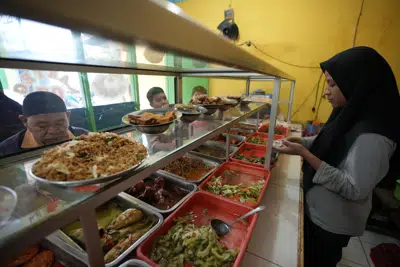
An Egyptian widow is struggling to afford meat and eggs for her five children. An exasperated German laundry owner watches as his energy bill jumps fivefold. Nigerian bakeries have shut their doors, unable to afford the exorbitant price of flour.
One year after Russia invaded Ukraine on Feb. 24, 2022, and caused widespread suffering, the global economy is still enduring the consequences — crunched supplies of grain, fertilizer and energy along with more inflation and economic uncertainty in a world that was already contending with too much of both.
As dismal as the war’s impact has been, there’s one consolation: It could have been worse. Companies and countries in the developed world have proved surprisingly resilient, so far avoiding the worst-case scenario of painful recession.
But in emerging economies, the pain has been more intense.
In Egypt, where nearly a third of the population lives in poverty, Halima Rabie has struggled for years to feed her five school-age children. Now, the 47-year-old widow has cut back on even the most basic groceries as prices keep rising.
“It’s become unbearable,” Rabie said, heading to her job as a cleaner at a state-run hospital in Cairo’s twin city of Giza. “Meat and eggs have become a luxury.”
In the United States and other wealthy countries, a painful surge in consumer prices, fueled in part by the war’s effect on oil prices, has steadily eased. It’s buoyed hopes that U.S. Federal Reserve inflation fighters will relent on interest rate increases that have threatened to tip the world’s biggest economy into recession and sent other currencies tumbling against the dollar.
China also dropped draconian zero-COVID lockdowns late last year that hobbled growth in the second-largest economy.
Some good fortune has helped, too: A warmer-than-usual winter has helped lower natural gas prices and limit the damage from an energy crisis after Russia largely cut off gas to Europe. Still, oil and gas prices were high enough to cushion the impact on the energy-exporting Russian economy
The war “is a human catastrophe,” said Adam Posen, president of the Peterson Institute for International Economics. “But its impact on the world economy is a passing shock.’’
Still, in ways big and small, the war is causing pain. In Europe, for example, natural gas prices are still three times what they were before Russia started massing troops on Ukraine’s border.
Sven Paar, who runs a commercial laundry in Walduern, southwest Germany, is facing a gas bill this year of about 165,000 euros ($176,000) — up from 30,000 euros ($32,000) last year — to run 12 heavy-duty machines that can wash 8 tons of laundry a day.
We have passed the prices on, one to one, to our customers,” Paar said.
So far, he has been able to keep his customers after showing them the energy bills that accompany the price increases.
“Fingers crossed, it’s working so far,” he said. “At the same time, the customers groan, and they have to pass the costs on to their own customers.”
While he’s kept his steady customers, they’re offering less business. Restaurants with fewer customers need fewer tablecloths washed. Several hotels closed in February rather than pay heating costs during their slow season, meaning fewer hotel sheets to clean.
Punishingly high food prices are inflicting particular hardship on the poor. The war has disrupted wheat, barley and cooking oil from Ukraine and Russia, major global suppliers for Africa, the Middle East and parts of Asia where many struggle with food insecurity. Russia also was the top supplier of fertilizer.
While a U.N.-brokered deal has allowed some food shipments from the Black Sea region, it’s up for renewal next month.
In Egypt, the world’s No. 1 wheat importer, Rabie took a second job at a private clinic in July but still struggles to keep up with rising prices. She earns less than $170 a month.
Rabie said she cooks meat once a month and has resorted to cheaper byproducts to ensure her children get protein. But even those are becoming harder to find.
The government urged Egyptians to try chicken feet and wings as an alternative source of protein — a suggestion met with scorn on social media but that also led to a spike in demand.
“Even the feet have become expensive,” Rabie said.





